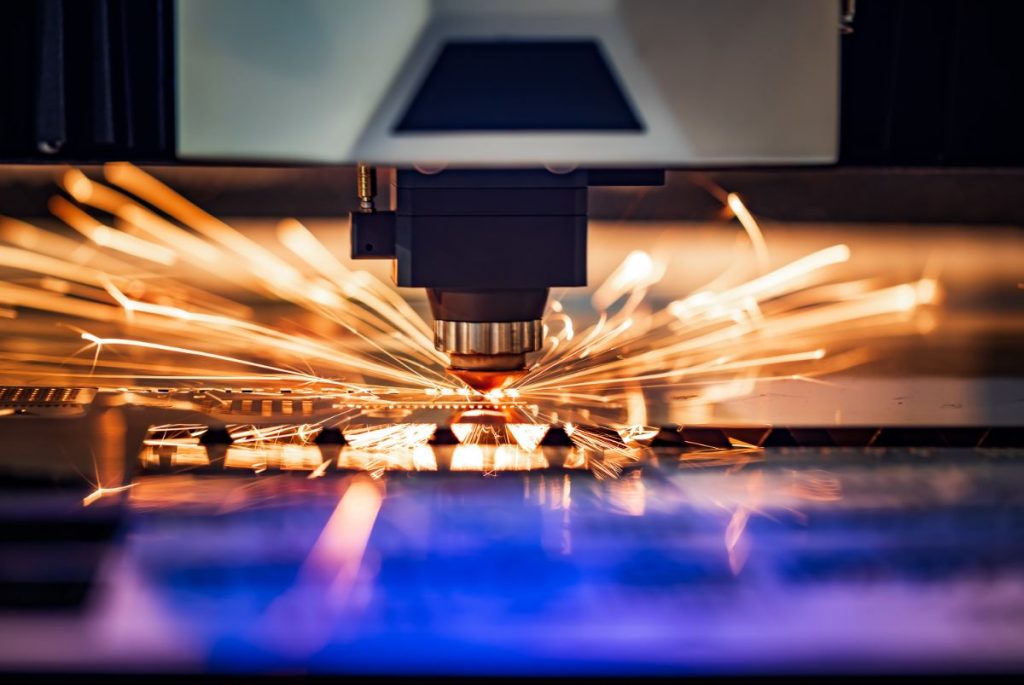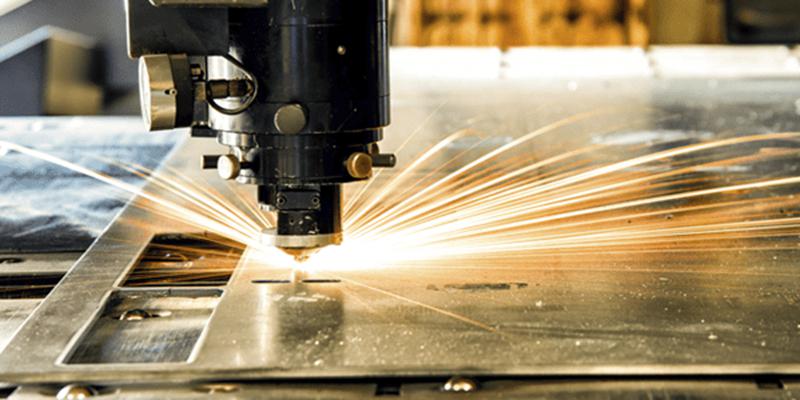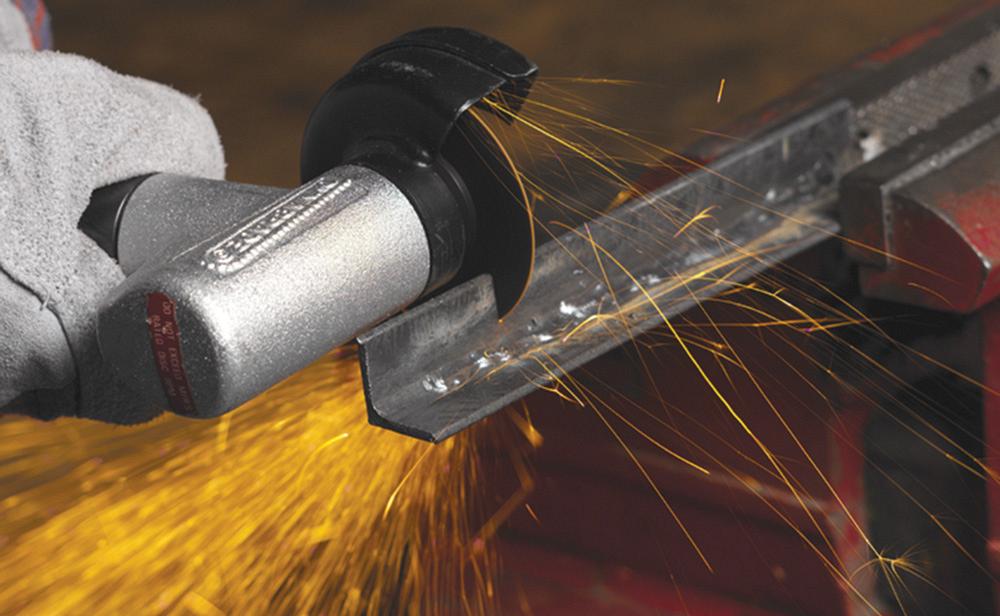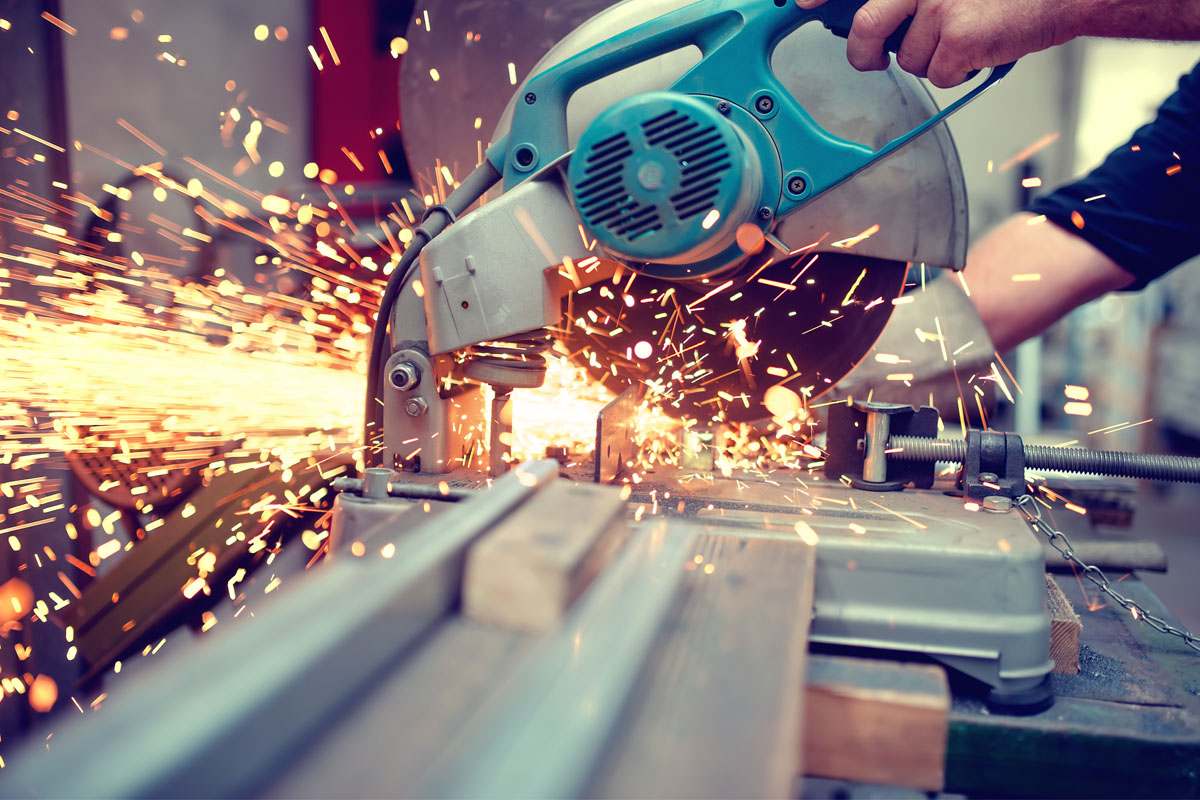
For as long as it has existed, metal has been one of the most versatile and reliable materials for manufacturing. Pretty much every manufacturing job is done with this material, and its usefulness has transcended centuries.
In recent times, however, much improvement has been made when it comes to working with this versatile material. And, part of that has been the growth in metal cutting.
In this article, we’ll dive into the metal cutting process and help you understand how it works – as well as the different available methods.
Metal Cutting: Meaning, History, And Working Principles
An Introduction to Metal Cutting
The name pretty much says it all, of course. In metal cutting, you have a process that involves the removal of a metal material from a workpiece as you look to achieve a definite size, shape, and surface finish.
Metal cutting is applied in different industries, with these operations usually being performed using different machines and cutting tools. And, you even have different methods available – which we’ll get to in a later section.
When it comes to how to cut metal rods or some other metal material, you usually make a choice based on factors such as the desired characteristics, the material being cut itself, and the production volume. All of these will come in handy when it comes to determining the manufacturing of different metal components, as well as the tools you use.
Significance of Metal Cutting in Manufacturing
As a process, the use of a metal cutting machine plays a prominent role in the production of different products across multiple industries. In general, the significance of the process in production can be attributed to different factors, including:
Operational Versatility
Metal cutting can easily work with different material options. It could be a pure metal or an alloy – as long as it can be cut, then this process works for it.
Accuracy & Precision
Whatever the option you choose, you have a higher chance of getting this task done with impressive accuracy.
Customization
Most manufacturers who engage a cutting metal tool will also be able to create more bespoke products. Once you have your design requirements, you can create something that fits it easily.
Mass Production
For producing high volumes of material, metal cutting helps to improve cost efficiency and reliability.
Complex Geometries
Some of the different types of cutting techniques can easily handle complex part geometries without a hitch.
Material Removal
The entire point of metal cutting is to remove excess material. This reduces the weight of materials while still ensuring proper structural integrity. Regardless of the industry, this is very important.
Economic Efficiency
When optimized, metal cutting can significantly help you to save costs. It reduces material waste and optimizes energy consumption, while also ensuring that labor costs can be cut considerably.
Competitive Advantage
When combined with advancements in digital manufacturing and automation, you’ll find that metal cutting can help manufacturers gain a significant competitive edge. The process improves productivity and reduces lead times, thus allowing manufacturers to better meet the demands of their customers.
How Metal Cutting Became An Industry
Metal cutting is a process that has a long history – almost a sling as the development of machines and tools themselves.
It’s easy to see metal cutting today and think that things just developed. However, the process has come a long way over the centuries.
From as far back as prehistoric times,metal cutting has operated. The use of simple stone tools was the order of the day in the prehistoric age, but those soon gave way for iron tools – in what we now know as the Iron Age.
In this age, blacksmiths were the primary drivers of the evolution of metal cutting. And with processes such as hammering and traditional tempering, they were able to set the pace for metallurgy and the changing of materials.
The next notable evolution of this process came in the Industrial Revolution. With inventions such as the steam engine, mechanization was rapid, and so was the creation of tools such as lathes and milling machines. All of these optimized efficiency in metal cutting considerably.
Over the past century, developments have led to tools such as Computer Numerical Control (CNC) technology, which helped bring automation to the metal cutting procedure.
In the current times, several advancements in material science and product coatings have led to improved metal cutting efficiency across the board. The process has become faster, more efficient, and more precise.
Types of Metal Cutting Processes

When embarking on a metal cutting operation, one of the most important things for you to consider will be the use of the metal cutting press and which of the techniques you want to engage.
This process is broadly varied, so understanding the different options will be critical for success.
Traditional Cutting Methods:
- Turning: In this process, you place the workpiece on the lathe and allow it to rotate. While this is done, the material is slowly taken out of the outer surface, creating the shape you require – in most cases, a cylinder.
- Milling: Next, you have a process that uses a spinning cutter moving across multiple axes to remove the excess material from the workpiece. Eventually, you’re left with a flat product.
- Drilling: With a twisted metal tool, you make holes in the workpiece. The drilling operation is quite flexible as it allows you to operate using different cutting edges. So, you’re free to cut as you like and create a custom shape.
- Sawing: The process is quite self-explanatory, of course – you take a saw and directly cut through the workpiece.
Advanced Cutting Methods:
- Electrical Discharge Machining: Known as “EDM” for short, this process makes use of electrical discharges to eliminate excess material from the workpiece.
- Laser Cutting: With laser cutting, you shoot a laser beam directly at the workpiece.
- Plasma Cutting: In plasma cutting, a high-temperature plasma arc is used to melt the material. You can find more about the process here.
Shearing and Punching
For shearing and punching, you majorly have two processes.
Shearing makes use of blades to pierce directly through the workpiece. The blades work in straight lines, so you have more control over what is cut.
As for punishing, you puncture holes directly into the workpiece.
Grinding
This process can be further divided into surface and cylindrical grinding.
Surface grinding uses a spinning wheel to remove excess workpiece materials. On the other hand, the cylindrical grinding process takes the same mechanism and works to create cylindrical shapes.
Electrochemical Machining (ECM)
This method seems a bit unconventional, and it combines an electrical current with an electrolyte to dissolve the workpiece slowly.
Eventually, the metal cutting process you select will be based on factors such as the nature of the material and what you’re looking to achieve on your own. At KDM Fabrication, we prioritize quality and will be more than happy to work with you in ensuring that you get the right metal cutting technique as you go.
Basic Principles of Metal Cutting
Just as you get with every other fabrication princess, metal cutting works based on the operation of certain basic principles that guide it. Essentially, these principles underlie the entire procedure involved in cutting metal tools, and you’d need to understand them to grasp how the process itself operates:
Shear Plane Formation
In this basic sense, the metal cutting process will need to work with the formation of a shear plane. Here, you separate the material with the cutting tool, which works along a predetermined path.
In most instances, the shear plane is created with the use of relative motion between the cutting tool and the workplace.
Material Removal Mechanism
Once the process itself is completed, you’d need to take the material out of the workpiece. This process is done with the use of mechanisms such as deformation, shearing, plowing, and more.
Now, it is important to remember that the mechanism you use will depend on different factors. Understanding and optimizing those will go a long way in helping your operation thrive.
Tool Material Hardness
The best metal cutting tools are usually made of materials that are stronger than the workpiece. Thanks to this difference in hardness, the cutting process can be more effective – especially with the cutting tool maintaining its own cutting edge.
Cutting Tool Geometry
You also need to pay close attention to the geometry and design when choosing the best metal cutting tool. Parameters such as relief angle, rake angle, and cutting edge angles should be optimized as they can influence factors like surface finish and chip wear.
Cutting Speed and Feed Rate
In this process, cutting speed describes the surface of the workpiece in connection to the cutting tool. On the other hand, the feed rate is the rate at which the tool is advanced into the workpiece.
Understanding and carefully adjusting these parameters will help you to better control the rate of material removal.
Chip Formation
Continued interaction between the workpiece and the cutting tool leads to swarf or chip generation. So, you need to be prepared for this.
Heat Generation and Management
The entire metal cutting procedure generates a considerable amount of heat as friction is generated. To that end, ensure that you have the right lubrication and cooling procedures intact to help manage this heat and prevent any form of workpiece deformation.
Cutting Forces
The overall cutting process generates different forces – from tangential and radial forces to axial forces and more. You’d need to understand and control these forces to ensure proper tool stability.
Tool Wear
Considering that the process of cutting metal tool options is done with high force and temperature, there’s always the possibility of tool wearing. As such, you’d need to manage this process and monitor the condition of all your tools as the process goes on.
Machine Rigidity and Stability
You want to ensure optimal stability and rigidity of your cutting machine to ensure that all forces are properly applied. This reduces vibrations and helps to optimize your accuracy in cutting.
Materials Needed For Metal Cutting

Metal cutting processes require particular tools and materials to operate efficiently and effectively. The combination of tools will vary based on the steel cutting methods and the workpiece material, but you can generally rely on the following components:
Primary Materials
Workpiece Material
Choose the right material based on your specifications and what you’re trying to achieve. You have different metal and alloy options, so take your time to make a decision.
Cutting Tool Material
Next, you want to consider the cutting tool. At the end of the day, remember that your tol should be stronger than the workpiece – or you could end up with a messy cut.
With that in mind, some of the more notable materials that can be used in the metal cutting machine include:
- High-Speed Steel (HSS): Here, you have material that works best for cutting soft metals – as well as some specific alloys.
- Diamond: Another material known for its hardness, diamond is perfect when you’re dealing with a tough workpiece.
Tools and Equipment:
Now, let’s examine some of the prominent equipment that are applied with the process itself:
- Lathe: A lathe is a tool that helps with turning operations. Typically, the workpiece is placed on it and allowed to rotate while the steel cutting machine goes to work.
- Milling Machine: For milling operations, you need to choose among the many types of metal cutting machines. And, milling machines will be your choice. Here, the cutting tool spins and moves among different axes to take out excess workpiece material.
- Drill Press: Used in drilling, this machine can come with tapping attachments as well to support threading.
- Grinder: These tools are used for cylindrical and surface grinding operations. They’re ideal for precision and delicate finishes.
- Sawing Equipment: Whether it’s a circular saw, a bandsaw, or a hacksaw, you can use different sawing tools to cut your workpiece into specific designs and shapes.
- Laser Cutting Machine: In the laser cutting process, a high-energy laser is used to sift through the workpiece. This process is also quite precise, and it is also ideal for thicker materials.
- Waterjet Cutting Machine: The waterjet cutting princess makes use of a high-pressure water stream, combining it with abrasive particles to produce the cutting effect.
- Plasma Cutting Machine: For this process, you need a high-temperature plasma arc that helps you to cut and melt the metal material. Like laser cutting, the process also works for thick materials.
Coolants and Lubricants:
In most cases, the ideal coolant in metal cutting is the cutting fluid. This helps to lubricate the cutting tool, take out heat, and improve overall chip evacuation. To reduce friction and wear, this component can’t possibly be overemphasized.
Safety Equipment:
To ensure the safety of everyone who operate metal cutting, remember the sue of the following:
- Personal Protective Equipment (PPE): Goggles, gloves, and appropriate clothing should be worn at all times to protect you.
- Machine Guards: When considering what machine cuts metal, look for an option with a safety guard that helps protect you from any moving parts and possible danger.
- Fire Suppression Systems: If you’re working in an environment where there is a risk of sparks and fire, then you’d need fire suppression systems to ensure safety.
Factors Influencing Metal Cutting Process Selection
We already pointed out the fact that there are different metal cutting processes available. However, when making a selection, it is important to consider a broad variety of factors. Some of these include:
- Workpiece Material: The type of alloy or metal you’re machining will need to be a primary factor in your decision-making process. Different materials have their properties, and you want to make sure that you choose the process that works with the material.
- Workpiece Size and Geometry: The shape, size, and complexity of your overall workpiece will also play a major role eventually. Some processes are better for producing intricate shapes, while others work better for simple geometries.
- Tolerance and Surface Finish Requirements: If you’re dealing with a high-precision part with a tight tolerance, then you might need to get a process with excellent dimensional control and surface finish uses.
- Production Volume: You have to be careful to consider your anticipated production volume. If you require high-volume production, then you need a process with optimal efficiency and speed.
- Material Thickness: Your workpiece material thickness influences your cutting method choice. Some processes work better for thin materials, while others are best suited for thicker pieces.
- Heat Sensitivity: If you’re working with a heat-sensitive material, then it goes without saying that you want a process that generates minimal heat. Laser and waterjet cutting easily come to mind.
- Tooling and Equipment Availability: The availability of specific tooling, machines, and equipment can impact the decision on cutting steel plate methods.
- Cutting Speed and Efficiency: You also need to keep an eye on your desired efficiency and production rate. An automatic metal cutting machine will be able to operate faster and more efficiently, but you should also keep other parameters in mind.
- Cost Considerations: At the end of the day, no one wants to spend so much money on metal cutting. As a result, consider the overhead costs – tooling, energy, labor, and tool maintenance – to ensure that you’re getting enough bang for your buck.
- Environmental Impact: With eco-friendly production being more of a priority, it might be worth considering the environmental impact of your operations in the long run.
- Safety Considerations: As much as possible, you want to optimize safety for everyone working on the laser cutting project.
- Lead Time: If you have an urgent production project, then you will need to consider that in process selection. Your lead time requirements will also come into play here, as some methods offer quicker turnaround than others.
Applications of Metal Cutting

Metal cutting is a very essential process that has been applied in several fields in the past. With its focus on precision in shaping and material removal, the process is useful in some of the following spaces:
Aerospace Industry
With metal cutting, aerospace industry players manufacture aircraft components – engine parts, landing gear, etc. The process also helps in cutting airfoils and turbine blades, and it helps to fabricate plane fasteners and connectors.
Automotive Industry
Vehicle manufacturers metal cutting to make engine blocks and other tools. From the frame and body to the exhaust pipes and chassis, metal cutting is required.
Construction and Infrastructure
The aluminum and steel materials used in building are produced using metal cutting. The process also helps to fabricate structural columns, beams, and more, as well as manufacturing different components for tunnels and bridges.
Energy Sector
We see this process being used in the energy sector to produce turbines, generators, andmore. Also, pipes used to transport oil and gas can be made with metal cutting.
Electronics and Electrical Industry
Metal cutting optimizes precision in manufacturing terminals and connectors. It optimizes heat sink fabrication, and it helps produce metal enclosures and housings.
Medical Device Manufacturing
Doctors, surgeons, and anyone else working in the medical field will require several tools. Metal working ensures that these components can be made – implants, devices, and more.
Given that these tools are used in the medical field, you want to always prioritize their biocompatibility and safety.
Consumer Goods and Appliances
We have many consumer goods today being made of metal. For them to be properly fabricated, the metal cutting process is employed.
Defense and Military
Vehicle components in the military space require machine cutting to be built. The process is also lent to the production of ammunition and firearms, as well as the development of protective gear.
Jewelry Making
Jewelry designers employ metal cutting’s focus on precision to help cut and shape precious metals. The process’s compatibility with creating intricate designs will also come in handy here.
Shipbuilding and Maritime Industry
Metals to be used in the marine industry have to be in top shape and overcome the harsh environments. However, metal cutting also helps ensure that these components can be cut and shaped. From hills to deck components and more, the process is used across the board in fabrication.
Mining and Heavy Equipment
In the mining space, metal cutting helps produce components that are used in mining machinery. It optimizes the fabrication of earthmoving and construction tools, thus bolstering the efficiency of mining operations.
Conclusion
Metal cutting is an intricate process that requires accuracy and efficiency to be done right. And considering its importance to overall manufacturing, it should go without saying that you need the right experts to get it done.
Fortunately, we at KDM Fabrication have you covered. Reach out to us today, and let’s see how we can help you out.





